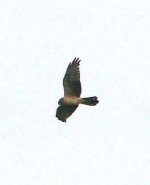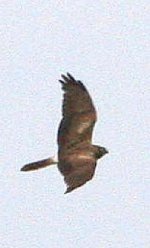Rob, my first reaction on seeing the photos was the same as yours when you first saw this bird in the field - on shape alone (wing-breadth compared to wing-length/tail-length/overall length of the bird), it has to be a Hen Harrier. I cannot believe that photographic effects could ever make Montagu's look this broad-winged. Pallid does look less narrow-winged than Monty's, though, so we have to rule this species out. That the bird is in moult is the obvious explanation for the 'incorrect' number of fingered primaries.
It's definitely not a juvenile of either Pallid or Monty's. They're much more vivid rusty-orange below. The extent of the warm colour on the rear flanks & underwings is surely within the range of juvenile Hen (see e.g. Plate 198 in Forsman's The Raptors of Europe and the Middle East). I also don't believe the underparts are unstreaked - I can see what appear to be streaks on the breast-sides at least; they could be artifacts due to the low resolution, but if so, then we have to conclude that the resolution isn't good enough to say that the bird is definitely unstreaked there either.
I don't really see anything in the head pattern that it incompatible with juvenile Hen Harrier. In terms of collars, I'm not sure what others are seeing but I see just a dark collar, with no pale behind it, and therefore no contrasting dark boa behind a pale collar either. The pale area is the bird's cheek. Pallid in juvenile and female plumages should show a narrow pale collar immediately behind the dark area, and this bird doesn't show that.
Re: the underwing pattern, a contrast between pale-looking primaries and dark-looking secondaries is fine for Hen - see e.g. plate 200 in Forsman. I'm straining to see the exact pattern of underside primary barring. "Boomerangs", as I understand them, are wide, boomerang shaped pale gaps between the bars at the base of the underside of the primaries that differ in shape & prominence between the three species; this bird doesn't show anything here, as far as I can tell, which is wrong for Hen. I don't think the photo has a high enough resolution to draw any conclusions about axillary barring - and this isn't a Yes/No feature - Pallid and Hen can be patterned here too - it's just that on Monty's the pattern is one of really obvious alternating rufous & pale bars. Prominence of the upperwing covert patch is surely fine for Hen too?
Steve






